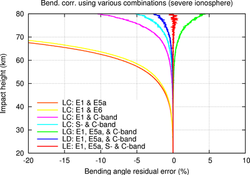Research Seminar - Stig Syndergaard

Date:12.06.2014 11:00-12:00
Location: Nordlys, DMI
With the implementation of the Galileo system, an additional signal source besides the GPS becomes available for GNSS radio occultation (RO). Additional frequency bands (S-band: 2483 – 2500 MHz & C-band: 5010 – 5030 MHz) are being considered for future generations of Galileo. Within the European GNSS Evolution Programme, we have investigated the future benefits of using Galileo signals for RO measurements, including possible S- and C-band signals. With additional frequencies in the S-band and C-band, it becomes possible to form triple and quadruple-frequency ionosphere-free combinations, which in principle would reduce higher-order systematic effects in RO in the stratosphere and above. However, while ionospheric scintillations can be quite severe at L-band frequencies, simulations show that they would be almost absent in the S-band and C-band. Thus, for stratospheric retrievals, it is better to avoid the lower L-band, and dual-frequency combinations involving E1, C- and/or S-band signals will generally perform better than using triple- and quadruple-frequency combinations involving also E5a. In the lower troposphere, S-band and/or C-band signals could contribute to a slightly better reconstruction of atmospheric profiles when atmospheric turbulence is present. A detailed link budget for S- and C-band shows that the signal to noise power density (C/No) values for these higher frequencies, would be smaller than at L-band frequencies. However, the smaller wavelengths for the higher requencies more than compensates for the lower C/No values, such that the phase noise (in units of length) is smallest at C-band.



